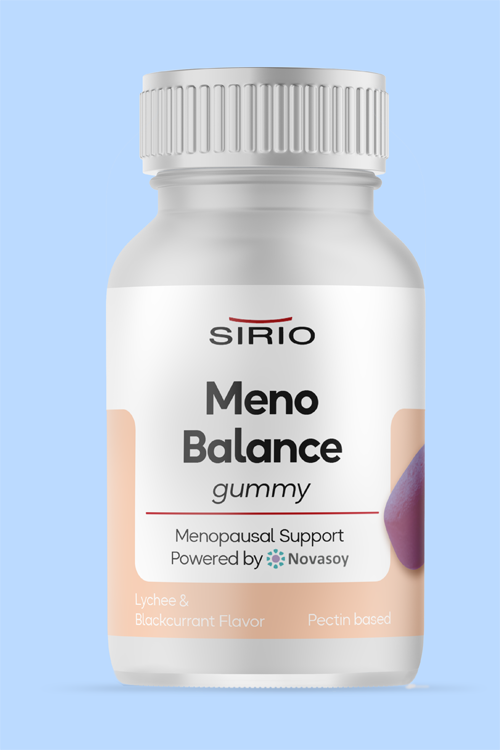During development, however, it became apparent that no matter how effective the active ingredients might be, market success relied on a positive taste experience. Dr Kevin Robinson spoke to Youyou Zhao, Head of Global R&D Centre at Sirio Pharma, to find out more.
KSR: Can you describe the specific bitter compound that was being masked in your gummy formulation and what challenges did its taste pose when creating a palatable product?
YZ: Masking bitterness in a gummy formulation is crucial to ensure consumer acceptability and compliance with daily supplementation.
For example, our gummy for premenopausal women incorporates ADM’s Novasoy, a soy isoflavone that’s scientifically proven to be helpful for hot flushes while supporting cognition and bone health.
Soy isoflavone is a bioactive compound found in soybeans. Despite their benefits, soy isoflavones can impart a bitter taste to products, which poses a significant challenge when creating a palatable gummy.
This bitterness stems from the chemical structure of isoflavones, which can interact with taste receptors on the tongue associated with bitterness — leading to an unpleasant taste sensation.
KSR: What taste masking techniques or strategies do you employ to overcome the bitterness of a compound in a gummy formulation?
YZ: To overcome the bitterness and achieve a pleasant taste profile in a gummy formulation, a variety of taste masking techniques can be employed.

For example, microencapsulation can encase the bitter compound and partially prevent its release until after it’s consumed, minimising the perception of bitterness.
Another approach is the use of flavouring agents. Although this may sound “less technical,” it requires highly skilled formulators to achieve a truly pleasant profile.
Fruit extracts or natural flavours are particularly well suited to produce a desirable taste that masks the bitterness of the active compound.
For example, citrus flavours such as orange or lemon can effectively disguise bitter compounds thanks to their strong and refreshing taste profiles. These flavours are not only effective in masking bitterness but also align well with the preferences of many consumers.
Additionally, sweetening solutions can be incorporated to add sweetness and counteract the bitterness to create a more palatable gummy. Natural sweeteners such as stevia or honey are often preferred to align with consumer demand for cleaner and more natural products.
The aim is, however, not to completely mask the plant-derived taste. We work to remove the bitterness while preserving some of the natural plant flavour. As we’re talking about nutraceutical gummies and not confectionery, consumers have different expectations.
They expect a pleasant taste but also expect to perceive the benefits of the gummy — and the taste reinforces the belief that the product will provide benefits. This is in many ways is the art of alchemy when in creating a world-class gummy.
KSR: How did you ensure that the taste masking techniques used did not compromise the overall quality or efficacy of the gummy formulation?
YZ: Great question! Ensuring that taste masking techniques do not compromise the overall quality or efficacy of the gummy formulation requires a comprehensive approach that considers both sensory attributes and functional properties.

Compatibility with the active ingredients is an essential starting point to maintain their stability and bioavailability throughout the manufacturing process and shelf-life of the product.
Stability studies, including accelerated and real-time stability testing, should be conducted to assess the impact of taste masking techniques on the integrity of the active compounds.
Additionally, we often go further and actively seek out consumer insights. These provide valuable information about which flavours, tastes and textures are popular with customers … and we use this information to improve the gummy.
By balancing taste masking with efficacy and quality considerations, we ensure that the final product meets both sensory and functional requirements.
KSR: What were some key considerations when selecting the excipients or ingredients to help with taste masking while maintaining the nutritional integrity of the gummy?
YZ: Compatibility with the active ingredients is paramount to ensure that taste masking agents do not interact negatively with the bioactive compounds or compromise their efficacy. We categorise our considerations into three main areas: functionality, flavour strategy and clean label, which is more customer centric.
Functionality involves ensuring that excipients and taste-masking agents do not compromise the active ingredients. They should not alter the pH or stability, as these changes could reduce the benefits of the gummy.
Stability is crucial to ensure that the active ingredients remain effective throughout the product’s shelf-life and during processing conditions.
The flavour strategy aims to create a flavour profile that evokes the desired taste in the consumer’s mind. For example, when using plant-derived natural actives, botanical flavours can enhance the perception of natural supplements and their benefits.
The flavour added to the gummy should be something the customer associates with the condition the gummy is designed to address.
For instance, in China, mothers often give their daughters red dates with sugar for period cramps. Hence, gummies for women in China have a red date flavour profile combined with active ingredients for women’s wellness.
Flavour strategy also involves the science of creating the correct taste profile on the consumer’s tongue. There are five primary flavour profiles: bitter, savoury, sweet, umami and sour. Interestingly, bitter, sweet and umami flavours share the same receptors on the tongue.
This is why offering something sweet can alleviate the discomfort of a bitter taste as the sugar molecules compete with the bitter compounds for the same receptors. Similarly, adding a bit of sugar to a soup can enhance its umami flavour.
When masking distasteful compounds, we use strategies to enhance the overall flavour experience. Different compounds have varying levels of bitterness, so we rely on sensory and ingredient technologies to address these differences.
One effective strategy to mask “off flavours” such as fishy tastes is encapsulation. This can be done using encapsulation techniques or sometimes by covering the compounds with lipids to remove the unpleasant taste. However, although encapsulation is effective, it can be expensive … so this is often a consideration as well.
Lastly, our clean label strategy focuses on using natural ingredients to meet consumer demand for transparency and simplicity. This approach not only aligns with market trends but also ensures the gummy maintains its nutritional integrity while delivering a pleasant sensory experience.
Minimising the use of flavours and additives is essential, as consumers increasingly prefer clean labels with fewer extra ingredients.
Seeking alternatives such as natural sweeteners, monk fruit extracts, honey or fruit purees instead of artificial flavours caters to current consumer preferences, a particularly strong trend that we are observing in Europe.
